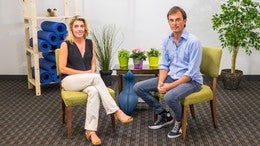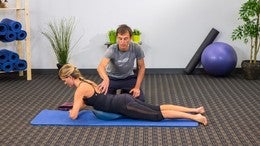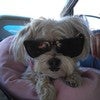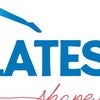Description
Before taking this class, we recommend watching Daniel's tutorial about how to use the Oov. It will help you know the correct placement in each position and how to make any adjustments you may need.
About This Video
Transcript
Read Full Transcript
Okay, we're going to do an [inaudible] class today. It's going to be an intermediate level and we're just going to have a little bit of fun and see how everyone goes. So it was the first thing we're going to do is we're going to sit our tailbones right on the very end of the large end of the you. And you almost want to have to be sitting up a little bit when you're in that right position, have a towel underneath your head. So when you're going to sit up a little bit high, right on the end of the year, perfect. And then you're coming back and to slow down, coming back, elbows on the ground and your hands on your lower ribs.
So what we're going to do, we're going to take one leg up into tabletop and our other leg up into tabletop. Now, if anyone felt anything in their neck when they were coming up, we're going to take our legs back down. We're going to move a little bit higher up the earth. If you head lifted up when you were coming down, Jan, I want you to just step a little bit higher. Why am you going to come up a little bit higher? Um, fantastic.
And take one leg down and another leg down. I'm just going to bring Christie [inaudible] just bring you down a little bit high. Just go back up into table top for me again. Awesome. Perfect. Okay, so just fade on the ground and now we're just going to relax. We're just going to start with some arm movements. Okay. The nice thing about the IRV is that your head's lower than your hips or you're going to start to feel as you're going to be breathing from your diaphragms. So you can't use your secondary respiratory muscles here.
So I want both arms up above you in front of you. Okay. We're going to just start with some our marks. We're going to take one arm slowly over the top of our head. Don't rest it on the ground, just holding it off the ground. We're going to keep tension in the system the whole time coming back.
As soon as you read something on the ground, you lose tension throughout all the tissues and then taking the other arm slowly coming up above your head, holding it there and coming back. And now what we're going to do, take both arms above your head and we're going to hold them just off the ground. We're going to take a few breaths feeling different tension through one shoulder and the other. You can start to feel what's going on in your bodies a little bit differently. And also in this position, it's a power pose.
This pose has been shown to actually reduce cortisol and increase testosterone, which is a great position and you'll feel also take a nice big deep breath. You're going to feel the space created for your diaphragm. Now coming back up with your arms. Now from them, we're going to take one arm up to the side and just hold it off the ground great and back and now the other arm out to the side and just holding it off the ground. Now how much, just taking that arm out to the side, Chris, a little bit more talk. So you're having to use a little bit more of your code just to balance on the, you've coming back up now, keeping both arms up and lifting one leg up into tabletop. Lots of little foot shuffling in there.
And for those who need it, what I'm gonna do is I'm going to grab it, pull out his bowl, we're gonna put it under the you fate. And that's good. Now we're going to start with our amaxx again. Taking one arm over the top.
And the other arm over the top. Great. And coming back both arms over the top, holding it there, holding it there. Fear how you have to correct yourself in this to keep your balance and coming back. Great. Now the opposite arm to the leg. You've got up in the air, you're going to take out to the side.
Just watching the person next to you. The opposite arm. Great. Coming back now the same side, huh? The same. Exactly. Holding that there, holding there and coming back. Fantastic. Take that leg down. Have a little bit of a rest, and now we're gonna. We're gonna Change. We're gonna change legs.
So lifting the other leg up.
And now the same side, I'm that the legs up in the air, you're going to take that out to your side. Lots of core control needed. It's not about as strong. Your core is. So also about how Ammo, how you can relax that shoulder coming back up again, both feet on the ground and is on the ground. Hands the sorry. Yup. Arms on the ground and have a little rest. So what we're gonna do is we're going to put our hands on our lower ribs, elbows on the ground, and we're going to go one leg up into tabletop and the other leg up in detail, which up, we're going to start to do some fame racks. We're going to do the first one slow.
So just taking one leg down really slowly. Don't rest it on the ground, just touching the ground and coming back. Now the other leg slowly. Now super slow movements. Fantastic coming back. So one leg down. If you feeling anything in neck, you're going to move up the move, Jan.
So I want you to just up a little bit and coming back and the other leg slow a slow you move. The more information your brain has about controlling that movement and back one leg down.
You're having to control your body the whole time you're having to really work the whole time. You're having to keep that tension through the system the whole time. Okay, so now we're going to do the same exercise, but we're going to speed it up a little bit. And for those who don't have any issues with their neck, we're going to introduce the chest lift. If you something, if you feel anything in your neck, you drop your head down. So hands on your lower ribs, elbows on the ground, taking one leg into tabletop, the other leg into table top. And for those who want, looking between their legs and we're going to go for it.
One, two, one, two, one, two, one, two, one, two, one, two, one, two, one, two, couple more. Two, one, two, one, two, one, two, one, two, tabletop. For me, head back down. One leg down to the ground and the other leg [inaudible]. Good. Feel different to the first one. Okay, so head position can change which chain you're going to turn on. So more anterior chain with that one. So now we're going to go one leg up into table top and the other leg up into tabletop. And we're going to do a single leg stretch.
So we're going to shoot our leg across the room, straightening and coming back and slow it down. This time and the other leg hold coming back. One leg out,
One leg. Oh, and back and the other leg. Oh, I'm back. We've got one more to do. One leg hold and back and the other leg hold.
Now as we took our legs out, did someone fit? Did everyone feel, did it actually made you work from a different part of your call? Yup. You had to use different muscles so your body will actually use whatever it needs to to create stability within a task, which is great. So we're going to go back up into table top again. So one leg up. Now the leg up for those who want lifting their head look between their legs. And we're going to speed it up.
We're going to do a double famer rock. We're going to take our feet down towards the flow and only go as far as he can and coming back. Excellent. Let yourself lose that control. So one both down and coming back. And again, really slowly coming
We're going to do about four mall down and
Now we're going to add a little bit more complexity to that one. We're going to start to feel our anteriors linked. So we're going to go one leg up into tabletop and the other leg up into tabletop. And what we're going to do now, same move both feet together, but this time let's take our feet over to the right of us and coming down towards the ground and coming back. Yup. And the feet just go down and coming down to yes, Eh, there we go. And then over to this one side, just keeping the knees nice and bent and the other side. So you're going to start to feel your anterior slings can talking to you.
Well, it's going to be really interesting also that you're going to find going to one side is going to be much easier than going to the other. So you're going to feel, which is your dominant sling and a couple more and one more one each. Memories side and back and the other side and coming back. One foot down on the ground. Other? Anyone feel anything with that one? Okay, so what? You'll feel different. Feel this link's working. The different obliques.
Really having to work as we took one leg out to the l and to different feel that there was one side easier than the other. Yup. So you picked up which was your dominant side. Awesome. So we're going to start doing some rollups now what I'm going to get you to do is slide your tailbone down towards the big end of the UW. Okay. We're going to keep up feet, knees bent on this one. Okay. We're going to start with our arms above our head.
Now if this is too hard you, the lower you go, the easier this is. They come down, come down lower, come down low. It's definitely where you want to start down low. Okay. To make these harder, you come up higher. Okay. So let's do around start nice and low. Okay. And what you want, you don't want to end up on the floor when you're up. So you want to just, you just want to make sure that your tailbone is right on the end. So one, you might need to just come up a little bit high up a little bit, just a little bit. Perfect. So arms above your head and bring them up in front of you and slowly one vertebrae at a time really slowly coming up and hold, hold, hold, hold. And now one vertebrae at a time. Let the material really give you the feedback of each segment as you're coming back. Fear how, how much feedback you get with that.
Now did anyone's hip flexes grab on that one? How come isn't it supposed to? That's usually why the hip flexes grab is because your body's trying to, you know, get your trunk and famebit closer together, coming back up. And when you're on the ground, your pelvis can't move. He hasn't got anywhere to go. So that's what's going to create that. Grabbing in the hips and coming slowly. We're going to do a few days and coming up and this you can feel for those who really struggle with a roll up, this almost facilitates that movement.
It creates that. And then what you then start to do and the idea, the move is that we encourage movement and then you, you, you're teaching the brain how to control that movement. So coming up, holding, holding, holding and coming back down again. Have a little rest when you're down because we're going to start to add a little bit of color with this one. And if I say that you know it's going to be interesting. Okay, so what we're going to do have a little rest for a second and then we're going to come up and we hold ourselves up in the seated position holding coming up hold. Okay. And then from here, from this position, I both hands on either side and we're going to reach over as far as he can with one arm. Keep the hands on the outside of the knee for me please and back and the other hand back and one back in the other one back, one back end, the other one back. And you're going to feel that your lower back supported and the other where it's going to facilitate the lateral flection to be coming from your thrust stick spine rather than from your lumbar spine. How are we going there guys?
Has anyone feeling anything yet? Come on. No, no, no. I'm having a chat up here with you guys. You've got to stay with me one more. Come on, come on, come on. Come on one more and rolling back down and taking the arms up. Have a little rest.
Have a risk cause we're going to actually add a little bit more color to that one. How did that feel? Do you feel your sling starting to talk? Yes, it's great. It's a great sign that they can't say anything. Okay, so from here. Okay. So from here, well you're going to bring our arms in front of his coming back up. Okay. And we're going to hold it. So we take our left time behind our head. I want you to say your elbow right hand on the outside of the your left knee. And we're going to pulse. One, two, three, four, five, six, seven, eight, nine, 10 sweatpants.
One, two, three, four, five, six, seven, eight, nine, 10. He wants another round coming back to it's okay. How did you find those? Ah, anterior slings. They're wonderful. They force closed the SACROILIAC joint ever. Really Great. So now rolling off on you, off your roof. To one side.
And what we're going to do is we're going to take out, oops. And we're going to turn them the other direction on our map. Okay. And we're going to sit this time in the saddle. The lower you go, the easier this is. Okay? So you're going to sit your sitting bones just on either side, down towards the cervical part of the, the cervical pattern.
Okay. And what we're going to do here is going to do another roll down, but the last time we actually encouraged extension in the lumbar spine. This time we're going to courage flection. So for anyone who's got a disc pathology, not an ideal exercise. Okay. Everyone's all good? Yup. Great. So from here we're going to allow our lower back to flex down into the material and coming back down.
And this time I think you can feel it's really going to open up your thoracic spine. And then from there bring the arms up
Okay? Now from here what we're going to do is we're going to lean back about 45 degrees, okay? And who can lift one leg up
All right, we're going to have a little bit of color on that one. We're going to speed this one up. So you're going to come above you in front of you and rolling up, leaning back 45 degrees. So the large end of the UWF supports your lower back. Okay? And we're going to start, who can do some munching on the spot again, if you feel anything in your hip flexes, it means you just laying back a bit and that'll actually take that away.
Okay? Keep going. You're doing really well. Okay. Who can straighten one leg out and back and the other leg out. Back one leg out by other [inaudible] back one leg back. Other leg out, back, one leg. The other leg. Both legs.
Who can do both legs and back down. Well done. It's tough, isn't it? Have Arrests? Exactly. Okay. So what are we going to do? Have a little rest in there. And now what we're going to do is we're going to take the oof and we're going to lie actually the move to the side of your mat, the large end to the right side of your mat. Put it in the middle of your mat.
And we're going to put our right knee right in the middle of the saddle. I left knee, just goes to the top of the roof and hands underneath his shoulders. And to do quadrupedal.
Give yourself some space here. So are we gonna bring one arm in front of you is careful of the other and coming back and the other arm.
Bring it back down and coming back out again. So it really working. The Right Glute made the lateral stabilizer on, on the side of your pelvis and the left glute Max and coming back down.
So now we're going to take our right arm and left leg out. Keep the right foot on the ground for now taking, coming up. Hold, hold. Now bring both back to each other to, to the, to neutral. Don't rest them on the ground though. And again, coming back up.
Fantastic. Hold. Feel how your body's having to figure this out and balance the whole way. Coming back down and again and holding. Now for those who want, who can lift their right foot off the ground and balance, holding, holding, holding for, do that right foot back down and taking right arm down, left leg down. Have a rest oil down. Turn the move the other way around.
So the large end facing the left hand side of your mat. This left knee in the middle. How did they feel? Everyone feel their posterior slings working on that one. Fantastic. Okay, so left knee and right foot at the top, top of the small end of the [inaudible], hands underneath your shoulders. And again, we're just going to take our arms up in front when I'm up and back down and the other, um, and what you're going to feel is one side's going to be easier than the other and one, um, and back and the other arm. And what's, what's the nice thing about the UV is you feel which sides just stronger side one arm up rather than someone telling you which is your strong or weak side. It becomes a objective experience. Okay, now both arms down on the ground and now we're going to take our right foot out to the side of the room, holding the leg parallel to the ground, holding that there. Great. Coming back down.
Just holding it off the ground for me and back again and hold. That's fantastic. And coming back down. Hold and again.
Holding that. That's great. Holding, coming back down. One more. Coming back up. Hold that. Then hold that there for those who want and who, who can lift the left foot off the ground in balance. Can you balance out there? Can you find that balance? Well done. Well done. Put that foot back down. Come down and have her wrist will held down. Okay, well done.
So what are we going to do now? We are all going to face me. We're going to lie. Bring first of all your heads, all on the inside of your met. Okay. And you're going to put for on this side your left hip into the saddle and on this side, your right hip into the saddle. Okay. And the earth fits into your side into yup, exactly. So yeah. Perfect. Yep. Coming down, elbow underneath your shoulder over underneath the shoulder. That's great. So it's almost like the earth supports you in this position.
Okay. So a lot of the time side work you really loaded into. Just moving up a little bit for you. One just coming up a little bit higher. Yeah. And just centric Sig. Get yourself central into the saddle. So from here, bend the bottom leg and we're just going to do a little bit of sideline, some lateral line, which is a really important line. It's a line of your body that actually keeps you square because they stabilized the sides of your body and you're going to feel when you're on the UHF, you're going to get lots of feedback of controlling your upper body while you're working your leg. From here, we're going to start to work into flection and extension and feel you're getting loads of feedback through your torso and you're going to feel one way. It's going to be easier to just control the movement, so you're going to feel which way is easy for you, flection or extension. Which way do you have to move more with your upper body to actually create that movement? That's called compensation. Okay. All right.
From here, leg circles. We're going to go one way. And you weren't feeling anything yet? No. Okay. We'll stay here a little bit longer. He going with those circles. Okay. Okay, and now the other way, how's this? How's everyone feeling?
So you can see everyone probably does the electrolyte and the glue made work, but only you have it changes everything because you're having to work your whole body. So we're going to do a few more little leg lifts. Come on, you can do it. Come on. I need some feedback here. I need and relaxing. Well done. Okay, so from him, we're going to stagger stance, get a nice long base and we're going to bring our arm over and we're just going to have a rest and really feel, but don't rest that arm on the ground. I want you to just hold it there and feel the difference.
What it feels like to actually hold that I'm off the ground and now arrested on the ground. Do you feel how all the attention goes out of your buddy? But holding that arm of that really keeps the tension in the body. That's where we want the body to work in a length and activation all the time. Now from he with your bottom elbow, we're going to bring that over and you're going to help yourself come up and hold and coming back down. For those who struggle, struggle with their nick, you can actually hold your head and support it if you need to and hold and coming back down. Yeah, for those who want, you can cross your arms over and coming up and hold feels very different, doesn't it?
And coming back to him and again coming up and holding. Stay up and we're going to pulse. One, two, three, four, five, six, seven, eight, nine. Anyone feeling anything? Taking that arm over the top and coming back. Jen. Well done. Changing sides. So facing me, changing sides. So on this side of the room, your right hip on this side of the room, your left hip. Ah, it's nice to get on the other side after all of that, isn't it? Okay.
Keeping that knee bent at the bottom leg and we're going to go back into some leg lift. Sorry. Okay. For those who want to add a little bit more color. You can use a little bit of leg weights on here just to make you work a little bit more to those who didn't feel anything in the first time around and from the intersection and extension. Okay? Feel which way is easier. Is it different to the last time?
Your body's having to work laterally all the time in standing and relax. Great. So stag, that stance, staggered leg, top, leg forward, button, laid back. Give yourself as much support as you need at home. You can push against something to give yourself most stability and top arm goes over the top, holding it off the ground to give yourself a really nice length and activation as opposed to a stretch. That's what plot is, is great at east centric activation. Okay, so from here, elbow into the, into the floor. I'm over the top. Coming up holding is one side. Is the side easier or harder than the other?
Harder coming back. Great. And again, coming up, isn't it amazing how quickly you pick up, which is your dominant side and which is not and Eh and again, Huh? And back. Now for those who um, you can cross that arm over and then coming up and hold. I'm back. Tie and rest. That leg, I'm on the ground and coming back up and hold. Good. I like hearing that and more. Oh, and then from here we're going to pulse. One, two, three, four, five, six, seven, eight, nine, 10. Hold it.
Can you come up a little bit higher for those who want you can support your head. Otherwise come back down. Rest, don't rest that arm yet on the ground is really give yourself a nice long activation there and relax. Okay, fantastic. So now what we're going to do, we're going to take the large end of our own. We're going to point it to the center of the room and we're going to turn the [inaudible] upside down. This right. Okay for you. I'll help you set up on this cause I know you haven't done this before. Okay. And we are going to do some prone extension work.
So coming up and you want the, the larger end of the, you have to really where your rib cages, it's going to sit and support just underneath that NT here. Yup. Come up a little bit. High One. Yep. And, and also, Jan, you want to come up a little bit higher. Thank you. So when heals, hit with the pop feet pointing out to the outside of the map. And what that does is externally rotate the hips and it's going to help with the SACROILIAC joint. No parent extension. A lot of the time is if you come up you can actually overextend into your lower back and miss. Where we really need a lot of extension is our thoracic lower thoracic spine.
So what are we going to do here is put our pelvis into a position. Can you just come up a little bit more Christie as well. Put our pelvis into a position that it's almost relaxing our lower back down this way so we have to extend more up into our lower thoracic spine. Yeah. Hands underneath the shoulders just on the outside of our shoulders and I want fingers pointing to the outside of the mat at 45 degrees and from here we are going to feel like we're going to pull that mat back and as we pull that map back, we're going to activate our, that leftism is Dorso and slowly lit a posterior sling.
Muscles bring us up and coming back to him. You shouldn't feel anything in your lower back. If you feel anything he lower back, you move up the move. Okay. From here. Again, pulling those hands back and feel how activating those muscles almost brings you up into extension because they can everyone feel that really pulling the hands back towards your hips. Hold and coming back to one more for me please.
Coming up, pulling those hands back and holding. Holding, holding. Fantastic. Now coming back down. Okay, from them. Now for those who want, we're going to go into an unassisted. If this is too advanced for you, keep doing those. So hands behind your head, elbows. I want you to be able to see them. So starting with your elbows on the ground and now you're coming back up into prone extension. Looking across the room, holding, holding and coming back down.
And again, don't rest your elbows down there. Hold, hold, hold and coming back down. And we're going to go one more time and we're going to stay up there. So coming up and holding now from here, if you're not sure you can have a look at me. We're going to take one elbow down to our hips and back the other one and back one. But the other one back one back. The other one. One, two, one more. And to keep going. One Damn.
The other one, two more. One and back. And one more and back. Coming back down. Really slowly. Hit on your hands on each other. Full head on the top of your back of your hand. Have a little rest here for a minute. How did that feel? Tough, isn't it?
Okay. So from him, the last thing we're going to do is lifting one leg up off the ground, hold and back and the other leg holding and
We're going to take one arm and the opposite lake hands on the ground for me and coming up and and back. Great. And now the other side, good and back. Just respite. Who picked their weak sides? The coming out, um, when the opposite leg holding and back. And now the other side holding and back a couple more when I'm opposite leg holding and back the other side and back one more each side when I'm holding him back. And now the other side holding hand back.
Well done to rolling off Firouz and we're going to go back to our original position, the large end facing the center of the room, having our towels underneath our heads. We're going to sit our tailbone right down on the end of the [inaudible] and we're going to come back down.
And what we're going to do, just have a few breaths in there and that fear where you're breathing from. Do you feel like your breaths coming in a little bit deeper? How's your diaphragm? We've just created lots of space in prone extensions so we should get some nice expansion in three lower ribs are really like seeing, looking across the room and seeing everyone's lower abdominals and abdominals working. So from here, we're going to take her arms out in front of us and we're going to take both arms over our heads and just holding them off the ground. They're back into that power pose and we're just going to do a few breaths here and just parading and fear how it, your arms in this position brings the breadth and even deeper into your abdominal cavity creates even more space for your diaphragm.
Diaphragm is such an important muscle. It's the only muscle that links into five systems within your, and it's the skeletal muscle. You can train it so it's so important to create space to actually allow the diaphragm to work correctly. Okay? Bring the arms back up, elbows back down on the ground, hands on the lower ribs. Just relaxing them. Thank you so much for the class. You guys all did really well. There was great.
There was a couple of you that we've never done anything with the earth before, so that was great that you guys, you guys did really well and hopefully you saw that you didn't, I didn't need to give you too much instruction. The hollow idea of the UHF was that you are having to figure it out as you went, and Uber was giving you feedback that you actually learned how to learn, how to control that movement, and there's plenty of room to move, but then you also had to learn how to control them and I hope you had fun. Yeah. Have you enjoyed it? Thank you so much. Thank you. And just when you're ready, coming off the earth, you're going to roll off to one side on t. Take your time coming up onto your hands and aes and coming up slowly.
Thanks so much. Thank you.
Comments

Thank you for your comments.
Lila, in the US and Europe, please contact Balanced Body if you are interested in purchasing an Oov.
Thank you again.
Daniel
When & where do you do workshops in Australia?
You need to be a subscriber to post a comment.
Please Log In or Create an Account to start your free trial.



































